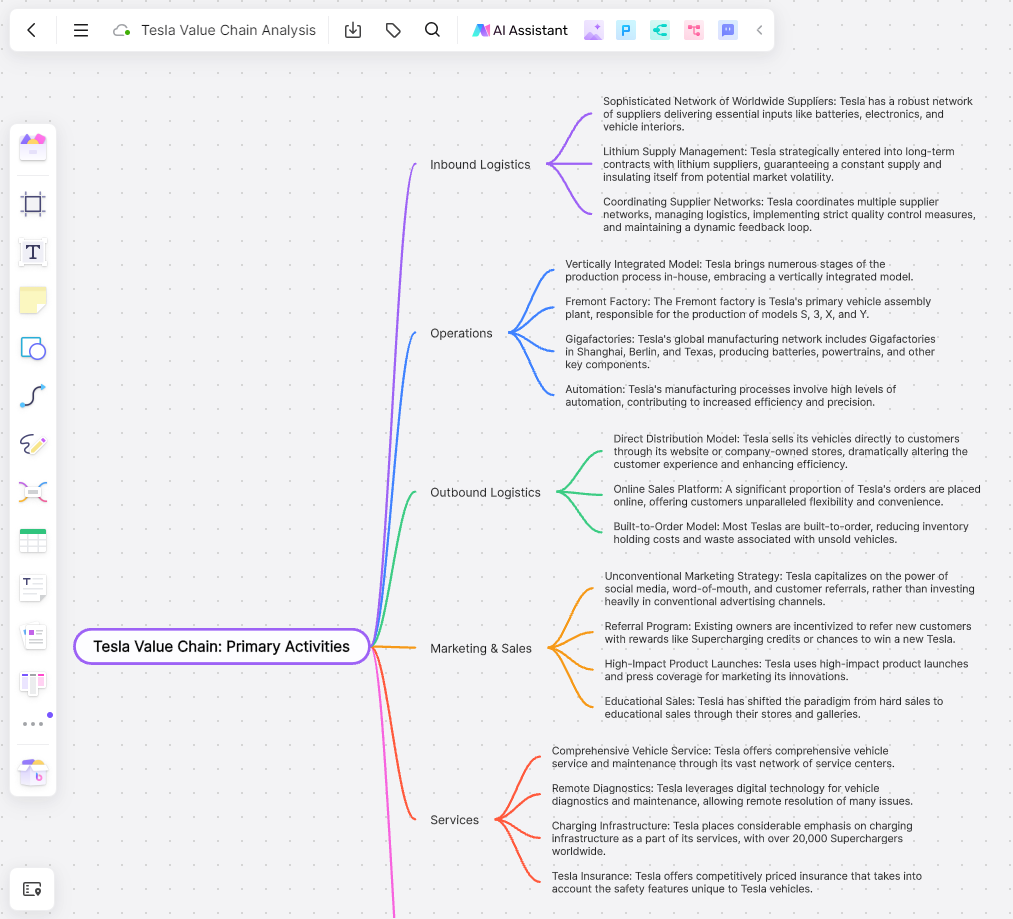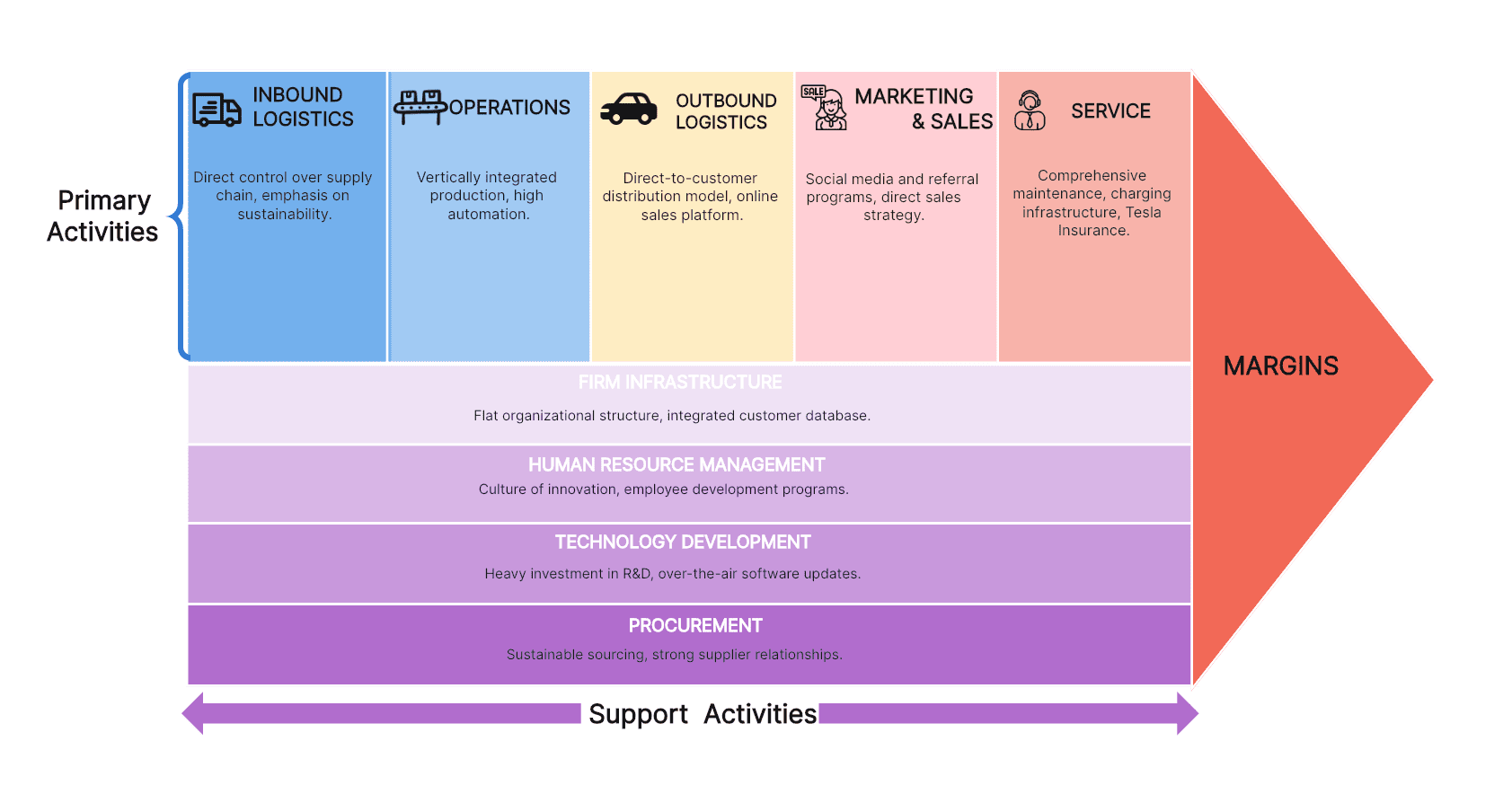Fueled by an era where sustainable, electric mobility has gained prominence, Tesla's ground-breaking value chain stands distinct. The remarkable journey of Tesla from a mere ambitious startup to a leading automotive and energy firm can be ascribed to its innovative value chain. In this comprehensive examination, we'll deep-dive into Tesla's primary and supporting activities that consolidate its unique value chain.

Primary Activities of Tesla Value Chain
Inbound Logistics
One of the remarkable facets of Tesla's success is its robust inbound logistics. For a car manufacturer, securing a steady flow of materials and components is critical. Tesla excels in this aspect, with a sophisticated network of worldwide suppliers delivering essential inputs like batteries, electronics, and vehicle interiors. The quality of these components directly affects the performance and efficiency of Tesla's electric vehicles.
Of particular interest is how Tesla manages its lithium supplies. Lithium is a critical element in electric vehicle (EV) batteries, and its supply can significantly impact production. Tesla strategically entered into long-term contracts with lithium suppliers, guaranteeing a constant supply and insulating itself from potential market volatility. This visionary move demonstrates Tesla's ability to anticipate potential supply chain disruptions and mitigate risks proactively.
However, the brilliance of Tesla's inbound logistics extends beyond securing resources. It involves coordinating multiple supplier networks, managing logistics, implementing strict quality control measures, and maintaining a dynamic feedback loop to continually enhance operational efficiency.
Tesla’s mastery over its inbound logistics has been fundamental to its manufacturing process, enabling the production of high-performance EVs that adhere to stringent quality standards. Moreover, the relationships Tesla has forged with its suppliers also contribute to its competitive advantage, playing a vital role in achieving its environmental sustainability objectives.
Operations
Tesla's unique approach to operations is pivotal to its status as a trailblazer in the automotive industry. Unlike many automakers that outsource a significant portion of their manufacturing, Tesla embraces a vertically integrated model, bringing numerous stages of the production process in-house.
A striking example of this is the renowned Fremont factory in California. Initially a General Motors and Toyota joint venture, this 5.3 million square foot facility was acquired by Tesla in 2010. It has since become Tesla's primary vehicle assembly plant, responsible for the production of models S, 3, X, and Y.
Yet, Fremont is just one component of Tesla’s ambitious global manufacturing network. Tesla's Gigafactories in Shanghai, Berlin, and Texas play critical roles in its production ecosystem. These vast facilities don’t just assemble vehicles; they produce batteries, powertrains, and other key components too.
For instance, at the Nevada Gigafactory (the largest building globally), Tesla produces more batteries in terms of kWh than all other carmakers combined. This integration provides considerable cost advantages and ensures an uncompromised focus on quality and innovation.
Additionally, Tesla’s manufacturing processes are noteworthy for their automation levels. A large part of the assembly is done using advanced robots, contributing to increased efficiency and precision. Despite some initial hiccups with over-automation, Tesla has mastered the balance between automated and manual processes.
Tesla’s operational strategy has not just been about high-tech factories and sophisticated robotics; it’s about crafting an ecosystem that harmonizes human ingenuity with technological advancement. It’s this radical approach to operations that positions Tesla at the forefront of automotive innovation.
Outbound Logistics
When it comes to outbound logistics, Tesla once again steps away from the traditional, choosing a distinctive approach that puts the customer at the forefront. Instead of relying on franchised dealerships to sell its vehicles, Tesla employs a direct distribution model, dramatically altering the customer experience and enhancing efficiency.
This model involves Tesla selling its vehicles directly to customers through its website or company-owned stores, including high-visibility galleries and showrooms. By 2019, Tesla had established more than 400 stores and service locations globally, ensuring coverage in key markets. This presence facilitates customers to test-drive, buy, or service their vehicles conveniently.
An integral part of this model is the online sales platform. A significant proportion of Tesla's orders are placed online, offering customers unparalleled flexibility and convenience. With just a few clicks, customers can customize their vehicles, secure financing, and even trade in their existing cars.
Tesla's direct approach offers several advantages. It eliminates intermediaries, providing control over sales processes and the customer experience. It also enables cost savings by cutting out dealer margins and simplifying the supply chain.
Additionally, direct sales offer better inventory management. Rather than manufacturing vehicles for dealership lots, most Teslas are built-to-order. This method reduces inventory holding costs and waste associated with unsold vehicles.
However, this model hasn't been without challenges. It has met resistance in many US states with laws favoring dealership franchises. Despite these roadblocks, Tesla has remained steadfast in championing a customer-centric model, setting a new precedent in the automotive industry’s outbound logistics.
Marketing & Sales
Tesla's marketing and sales strategy is as disruptive as its electric vehicles. Instead of investing heavily in conventional advertising channels, Tesla capitalizes on the power of social media, word-of-mouth, and customer referrals.
The spearhead of Tesla's unconventional marketing strategy is its CEO, Elon Musk. His over 70 million Twitter followers turn every tweet into a news headline, giving Tesla massive free publicity. For instance, his tweet about Tesla's Cybertruck broke the internet and received millions of engagements within hours.
Tesla’s referral program also plays a vital role in its marketing strategy. Existing owners are incentivized to refer new customers with rewards like Supercharging credits or chances to win a new Tesla. This has proven highly effective, with customers becoming brand advocates and creating a strong community around the brand.
Moreover, Tesla also employs high-impact product launches and press coverage for marketing its innovations. The 2020 Battery Day event had over 270,000 livestream viewers, effectively reaching a broad audience without traditional advertising costs.
When it comes to sales, Tesla’s online platform plays a crucial role. Tesla’s built-to-order model allows customers to customize their vehicles directly on the website before placing the order.
Furthermore, Tesla has shifted the paradigm from hard sales to educational sales through their stores and galleries. These locations allow potential customers to learn about electric vehicles and experience Tesla's cutting-edge technology firsthand.
By combining innovative, low-cost marketing with direct sales, Tesla has effectively bypassed traditional marketing channels, creating a powerful brand with a loyal customer base while reducing marketing costs.
Services
Tesla’s unique approach extends to its post-sale services, ensuring that customer experience remains paramount long after the purchase. Recognizing the evolving needs of its customer base, Tesla has developed a suite of services that makes owning and maintaining a Tesla as smooth as possible.
One of the primary services Tesla offers is comprehensive vehicle service and maintenance through its vast network of service centers. Unlike traditional automakers, Tesla's service centers are company-owned, providing a uniform and high-quality service experience. This network is continually expanding, with over 466 service centers operating worldwide as of 2020.
Beyond physical service centers, Tesla leverages digital technology for vehicle diagnostics and maintenance. Remote diagnostics allow Tesla to identify and resolve many issues without the need for a service center visit. When a visit is required, Tesla offers Mobile Service, where technicians can perform most service tasks at the owner's home or office, further enhancing convenience.
Tesla also places considerable emphasis on charging infrastructure as a part of its services. The Tesla Supercharger network, with over 20,000 Superchargers worldwide, provides high-speed charging solutions, reducing charging times drastically compared to conventional chargers. This commitment to infrastructure is a critical part of Tesla's strategy to facilitate the transition to electric vehicles.
Furthermore, Tesla’s services extend to insurance offering – Tesla Insurance. Available in select US states, it provides competitively priced insurance that takes into account the safety features unique to Tesla vehicles.

Support Activities of Tesla Value Chain
While the primary activities directly add value to the product, the support activities of Tesla's value chain play a crucial role in enhancing its capabilities and competitiveness.
Firm Infrastructure
Tesla's firm infrastructure, including its corporate structure and management systems, is tailored for innovation and rapid growth. Its flat organizational structure empowers employees, encouraging innovation and agility.
Moreover, Tesla's unique infrastructure includes an integrated customer database that allows seamless communication between sales, service, and other departments. It ensures coordinated customer experience across all touchpoints.
Human Resource Management
Tesla's human resource strategy revolves around attracting, developing, and retaining top talent committed to its mission of accelerating sustainable energy. With over 70,000 employees worldwide, Tesla emphasizes a culture of innovation, inclusivity, and sustainability.
Employee development is a priority, with initiatives such as the START program that provides students with hands-on technical training on electric vehicles. Furthermore, Tesla's compensation strategy aligns employee performance with the company's objectives, rewarding both individual and company-wide successes.
Technology Development
Tesla is well-known for its commitment to technology and innovation. The company invests heavily in research and development (R&D), with expenditures reaching $1.5 billion in 2020. Tesla's R&D focuses on various aspects such as battery technology, self-driving technology, manufacturing automation, and energy storage solutions.
Tesla’s software-based approach to vehicle design is a crucial element of its technological advantage. Over-the-air software updates allow Tesla to enhance vehicle functionality post-delivery, improving customer experience continuously.
Procurement
Lastly, Tesla’s procurement strategy ensures it sources high-quality components from trusted suppliers worldwide. Besides components for vehicles, procurement also includes raw materials for battery production and manufacturing equipment for its factories.
Its procurement policies prioritize sustainability, aligning with Tesla's overall environmental objectives. Additionally, strong supplier relationships contribute to Tesla’s resilience against supply chain disruptions.

Tesla Value Chain Analysis Example
To visualize these complex interactions and relationships that form the Tesla value chain, refer to this Tesla Value Chain Analysis Diagram. This handy resource will help business professionals quickly comprehend the integral processes and decisions shaping Tesla's unique value chain.

Key Takeaways
Through this comprehensive Tesla Value Chain Analysis, we gain profound insights into how Tesla has masterfully harnessed its primary and support activities to drive its success. The company’s strategic control over its supply chain, coupled with innovative technology development and a direct sales model, has positioned it uniquely in the market.
As we’ve observed, complex strategic planning and management like this can be significantly simplified with the right tools. For this purpose, we recommend you use Boardmix, our flexible and feature-rich whiteboard solution. With pre-built templates like the Value Chain, you can effortlessly structure, analyze, and visualize your strategies in one place.
Of course, you need to develop your business model to ensure your company has more precise goals and workflow. Diagramming software is an excellent tool to use when you map your business model. Boardmix provides a pre-built business model canvas template. The diagram is customizable, so you can edit the colors, texts, and shapes and insert images and stickers to make it your own.
Features of Creating a Business Model Canvas on Boardmix
Developing a Business Model Canvas is a strategic activity often undertaken by startups and established businesses to identify and plan out different business aspects. Boardmix online whiteboard has numerous features that make this process more intuitive, efficient, and collaborative.

1. Interactive Whiteboard Interface
Boardmix's digital whiteboard allows users to visually layout and connect various components of the Business Model Canvas, like Key Partners, Value Propositions, Customer Segments, etc. The ability to write, draw, or annotate on the board facilitates clear expression of ideas.
2. Real-time Collaboration
Boardmix’s collaboration feature enables teams to work on the same Business Model Canvas simultaneously. This real-time interaction allows for immediate feedback, brainstorming, and iteration, which can significantly enhance the canvas’s quality and relevance.
3. Drag-and-Drop Functionality
Reorganizing ideas and elements is made easy with Boardmix’s drag-and-drop functionality. This feature helps to effortlessly structure or restructure the canvas, making the modeling process flexible and adaptive to evolving business strategies.
4. Multimedia Integration
Supplement your Business Model Canvas with rich multimedia content. Integrate images, documents, or even video clips directly into the canvas to provide additional context or explanation, enhancing comprehension and engagement.
5. AI-Enhanced Brainstorming
Boardmix’s AI enhancement feature can stimulate brainstorming by suggesting related concepts based on the inputs you provide for your Business Model Canvas. This innovative feature can contribute to the development of a comprehensive and robust business model.
6. Ready-to-use Templates
Boardmix offers pre-made Business Model Canvas templates, accelerating the modeling process. These templates provide a well-structured format that can be readily filled in with business-specific details.
7. Secure Cloud Storage
With Boardmix, you never have to worry about losing your work. Your Business Model Canvas gets auto-saved and stored securely in the cloud. This means you can access your canvas from anywhere and at any time.
By utilizing these features of Boardmix Online Whiteboard, developing a comprehensive and visually engaging Business Model Canvas becomes an enjoyable and effective process.













